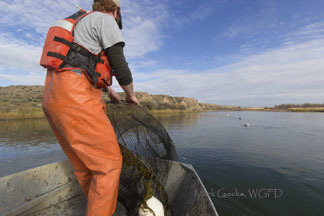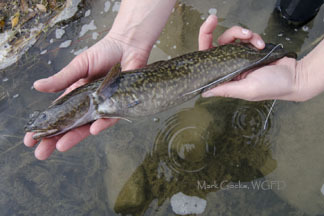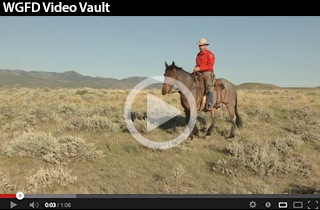WGFD Initiates Study on Non-native Burbot
Wyoming Game & Fish Department sent this bulletin at 12/18/2013 11:57 AM MST 
|
|
Having trouble viewing this email? View it as a Web page. |
PINEDALE - The Wyoming Game and Fish Department has teamed up with researchers from the University of Idaho and Trout Unlimited to learn more about an illegally introduced population of burbot in the Green River drainage in southwest Wyoming. Ultimately, fish managers hope to use the information to more efficiently implement control actions on the non-native invasive fish species that is impacting native fish populations.
 Zach Klein, a Master's Student in Fisheries Resources at the University of Idaho, retrieves a net set to catch burbot from the Green River near LaBarge.
Zach Klein, a Master's Student in Fisheries Resources at the University of Idaho, retrieves a net set to catch burbot from the Green River near LaBarge.
Burbot, also known as “ling”, are a species of fish in the cod family with a native range that extends into portions of north-central Wyoming, including the Wind and Bighorn River drainages. While most members of the cod family reside in the ocean, this specialized fish has adapted to the cold, freshwater environments of Asia, Europe, Alaska, Canada and the Northern United States.
Sometime during the late 20th century, burbot, not native to the Green River, were illegally introduced, likely forever altering this renowned river system. Burbot are a voracious predator as adults and prey almost exclusively on other fish or crayfish. Upon their introduction, burbot have almost immediately begun having impacts on important native and recreational fisheries of the Green River.
Flaming Gorge, Fontenelle, and Big Sandy reservoirs have seen dramatic changes to some sport fish and important forage fish populations, especially smallmouth bass, which appear especially susceptible to burbot predation. Native populations of some imperiled fish species also saw drastic changes as burbot became established and began preying on some of these rare species. In particular, recruitment of juvenile bluehead and flannelmouth suckers has not occurred in some streams since burbot became established.
Burbot have rapidly expanded and established themselves throughout the Green River drainage. To date, they have successfully pioneered the Green and New Fork rivers above Fontenelle Reservoir, and may likely make their way into the popular “Finger Lakes” along the Wind River front in the Upper Green River drainage. Data collected in 2013 shows that burbot have now become established in the Green River just below the town of Daniel, approximately 35 miles upstream of where they had previously been found.
Extensive work has been conducted by the Wyoming Game and Fish Department to identify effective capture methods in lakes and reservoirs and to study their ecology and feeding habits in standing waters. Intensified sampling in the “Finger Lakes” has yet to yield any burbot, but with little standing in their way they are expected to soon become established there.
Burbot living in large rivers and streams have received far less management attention. Burbot have occasionally been captured by biologists during routine sampling on the Green and New Fork rivers, but little is known about the effectiveness of capture methods in flowing water or how burbot are using these habitats.
The current research being conducted by the Game and Fish Department and the University of Idaho aims to study the effectiveness of various sampling gears for capturing burbot in flowing water, learn more about how they are potentially affecting this world-class sport fishery and what actions can be taken to prevent such negative impacts. Researchers are also capturing burbot and implanting them with radio-transmitters to track their travels and learn more about their distribution and the different habitats they use.
 A burbot surgically implanted with a small radio-transmitter before being released back into the Green River, near LaBarge.
A burbot surgically implanted with a small radio-transmitter before being released back into the Green River, near LaBarge.
Ironically, burbot populations throughout their native range in other parts of the world are on the decline and biologists are working hard to conserve these populations. Managers are hoping the information learned from this illegally introduced population can be applied to other native populations to help conserve them.
~ WGFD ~


